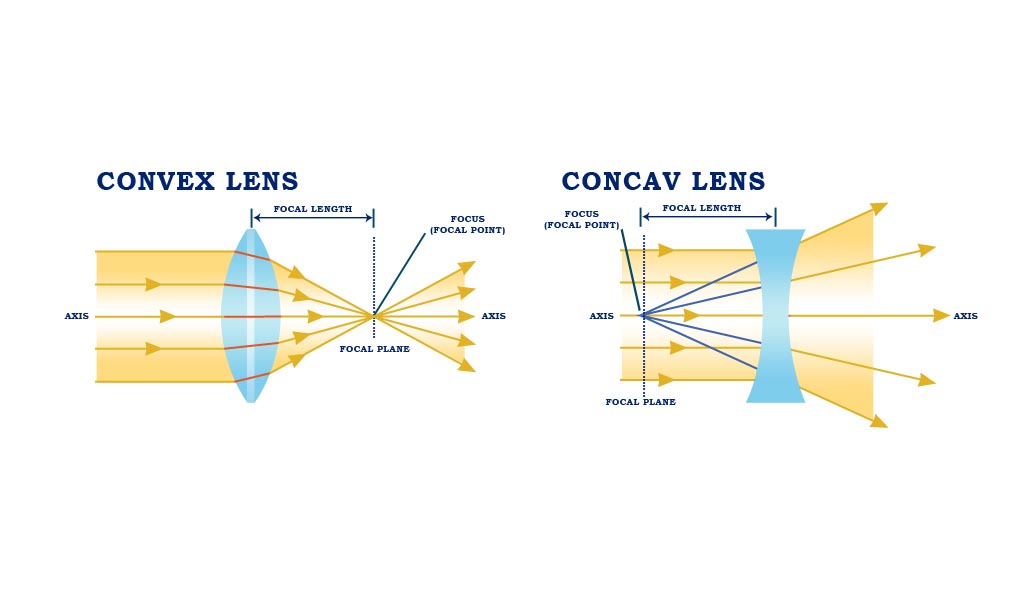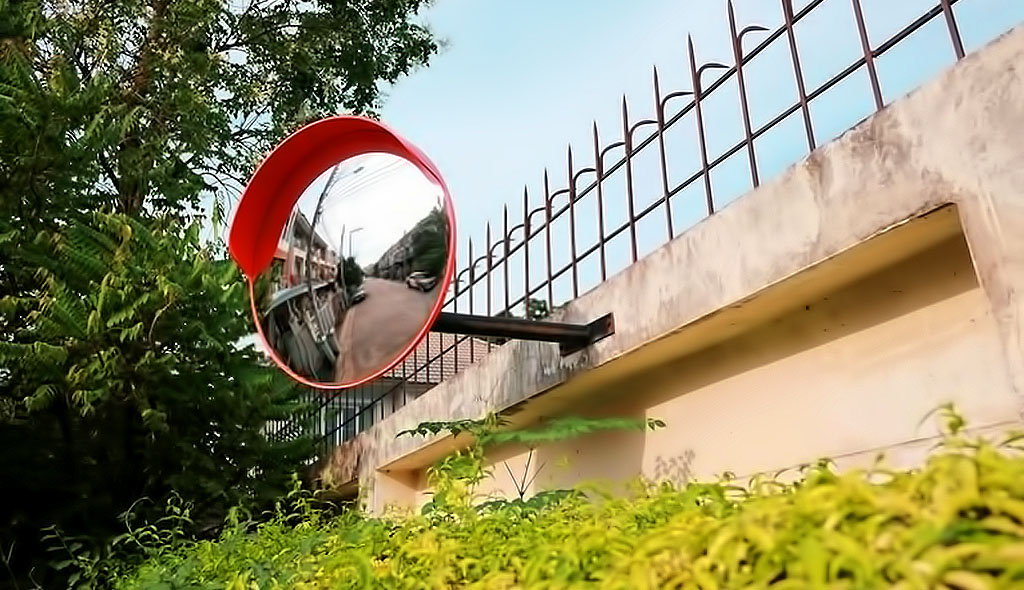Difference Between Concave and Convex Lens

Concave and Convex Lenses
Perhaps all of us are familiar with eyeglasses. They are used to correct some types of vision problems like myopia and hypermetropia. These eyeglasses for vision correction are prescribed by doctors when we can’t see clearly.
But what are the specific features of those glasses, that when we use them our vision becomes clear? It’s because these glasses are not ordinary glasses but a specific type of optical tools known as lenses.
A lens is an optical tool that converges or diverges a beam of light through refraction. So, based on its type, it can either focus or spread a light beam. A lens is often made of glass but can also be made of any transparent material like plastic.
When only a single piece of transparent material is used, it is called a single lens. A composite lens is a setup of several single lenses normally lying along a common axis.
Now, based on its shape, the lens can be divided into two types; Convex lens and Concave lens. These lenses apart from finding their use in eyeglasses are also used in several other optical instruments like cameras, microscopes, magnifying glasses, and many others.
So, the lens being such an important optical tool with such diverse applications, let’s learn about it in detail.
What are the Concave and Convex Lenses?
As mentioned, there are two types of lenses based on their shape. The one that is thicker at the middle and gets thinner as we move towards the edges is called a convex lens. And the one which is thinner at the center gradually thickening as we move towards the edges is known as a concave lens.
Convex Lens
Convex lens or converging lens as sometimes called is used to converge a light beam from a source from one side to a point on the other side. If the lens consists of two spherical surfaces, it is called a biconvex lens. If it contains one spherical and one plane side, then it is called a Plano-convex lens.
When the object is placed far away from the convex lens, the rays of light immerging from it can be held parallel for all practical purposes. When such a parallel beam of light passes through a convex lens, the refracted rays converge at a point. That point is called the principal focus of the convex lens. And the distance between the principal focus and the center of the lens is called the focal length.
Concave Lens
A beam of light passing through a concave lens after refraction diverges or spread out. For that reason, a concave lens is also known as a diverging lens.
Parallel rays of light passing through a concave lens diverge so that they appear to be coming from a point. This point is called the principal focus of the concave lens and the distance between this point and the center of the lens is called the focal length.
Types of Images Formed by Lenses
The images formed by a lens can be:
- Magnified or diminished, i.e. either bigger than the object or smaller than it.
- Erect or inverted, i.e. the image can be the same way up as the object or can be upside down.
- Real or virtual
A real image is an image that can be projected onto a screen. A virtual image cannot be projected onto a screen and appears to be coming from behind the lens.
Characteristics of Images Formed by a Convex Lens
Based on where the object is placed, a particular convex lens can form different types of images. The images can be either real and inverted or virtual and erect. The size of the image too can be diminished or magnified. The types of images formed by a convex lens are given below in a table for your convenience.
| IMAGE FORMED BY A CONVEX LENS | |||
| Location of Object | Location of Image | Nature of Image | Size of Image |
| Infinity | Focus | Real and Inverted | Diminished |
| Beyond 2F1 | Between 2F2 and F2 | Real and Inverted | Diminished |
| Between 2F1 and F1 | Beyond 2F2 | Real and Inverted | Magnified |
| At F1 | At infinity | Real and Inverted | Magnified |
| At 2F1 | At 2F2 | Real and Inverted | Same size |
| Between F1 and 0 | On the same size as the object | Virtual and Erect | Magnified |
Here, F1 and F2 are the focal lengths of the convex lens at the object side and the image side respectively.
0 is referred to as the center of the lens.
Characteristics of Images formed by a Concave Lens
The images formed by a concave lens are always:
- Virtual
- Erect
- Diminished
Uses of Convex Lens
Convex lenses find their use in several optical devices like microscopes, cameras, magnifying glasses, and eyeglasses to name a few. Convex lens and some of its uses are elaborated below.
Used in Eyeglasses
The convex lens is used to correct vision problems like farsightedness or hyperopia. It’s a condition where you can see distant objects clearly but the objects closer to the eyes appear blurry. In a farsighted person, the image is formed far behind the retina instead of on it. The use of convex lens eyeglasses helps to correct this vision problem by reducing the focal length and thus form the image on the retina which helps the person to see clearly.

Used in Microscopes
A convex lens is used in a microscope to generate extremely magnified images of very small objects. A microscope often uses a combination of lenses.
Why is Convex Lens Used as a Magnifying Glass?
A magnifying glass is a tool for viewing magnified images of objects close to the eyes. When an object is placed between the first principal focus and the center of the lens, according to the property of a convex lens, an image is formed on the same side of the object which is erect, magnified, and virtual.
This property of a convex lens is utilized and it is used as a magnifying glass to view images that are magnified and erect.
Uses of Concave Lens
The concave lens refracts and diverges light rays passing through it. A concave lens too has several uses. Some of them are mentioned below.
Used as Eyeglasses
A concave lens is used to correct the vision problem of myopia or shortsightedness. A person with myopia sees the closer objects clearly but finds far-away objects to be blurry. This is because in a person with nearsightedness, the image of a distant object falls short of the retina. Concave lenses correct this problem by spreading the light before it enters the eyes and thus helps the person see clearly.
Used as Flashlights
Concave lenses are used in flashlights to produce a wider beam. The light falls on the concave side of the lens and the rays diverge on the other side thus increasing the apparent radius of the source. This helps in producing a wider beam of light.
Used in Peepholes
Peepholes or door viewers are installed on the doors and gives a panoramic view of the objects outside. It uses one or a combination of concave lenses to minimize the proportions of individual objects and give a wide view of the entire area.
Concave VS Convex Lens: Difference Chart
As is pointed out in this article there are several differences between the concave and convex lens. Below we have provided a comparison chart for your convenience.
| BASIS FOR COMPARISON | CONCAVE LENS | CONVEX LENS |
| Definition | A lens that diverges light rays | A lens that converges light rays |
| Shape | Thinner at the middle and gradually thickening towards the edges | Thicker at the middle and thinner at the edges |
| Focal Length | Negative | Positive |
| Image | Mostly Real and Inverted | Virtual, erect and diminished |
| Used to | Correct Myopia | Correct Hyperopia |
What Are the Uses of Concave and Convex Mirrors
A mirror is a smooth and highly polished reflecting surface. Images formed by a mirror can be either real or virtual depending on the type of mirror. The most common type of mirror is a plane mirror. Mirrors that are part of a sphere are called spherical or curved mirrors.
Curved mirrors are again of two types: Concave Mirror and Convex Mirror.
Convex Mirror

In a convex mirror, the reflective surface bulges out towards the light source. The reflected rays diverge and the image formed is virtual, erect, and smaller in size than the object. But as the object gets nearer the mirror, the image size increases. Convex mirrors are also known as diverging mirrors.
Uses of Convex Mirrors
Convex mirrors always form virtual and diminished images of objects. Also, the field of view of convex mirrors is much larger than plane mirrors. So, convex mirrors are used where a large area and large objects are to be viewed in a concise form. So, convex mirrors find their use in several places including:
- Rear-view mirror in vehicles
- Inside buildings
- Security Purposes like inside big malls
Concave Mirror
A concave mirror has its reflective surface bulging away from the light source. This type of mirrors converges or focuses the light rays upon reflection. Hence they are also called converging mirrors.
Uses of Concave Mirrors
Concave mirrors are used to focus the light rays coming from the object. They can form different image types depending on the distance between the mirror and the object. Concave mirrors are most commonly used as:
- Shaving mirrors
- Head mirrors by E.N.T. specialists
- Ophthalmoscope
- Astronomical Telescopes
Conclusion
Concave and convex lenses, as discussed, are very important optical tools and are used in daily lives for different purposes. From magnifying glasses to eyeglasses, lenses find their use everywhere. The way the light is refracted (converged or diverged) determines the type of lens and also gives us an idea as to how they are to be used. Most complex optical instruments use a combination of concave and convex lenses to best meet their purpose.
So, that’s it. We have discussed concave and convex lenses and also briefly described concave and convex mirrors. Hope by now you have a better understanding of what lenses are and how they work. Take a look at some of our other course lessons for a better understanding and getting help with your academics.

